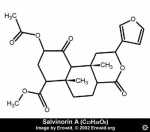|
Are salvinorin and THC really "thujone derivatives"?
| Q: |
I understand that Salvia divinorum is an uncontrolled substance in the United States and that the chemical is unrelated to other scheduled chemicals. The DEA webpage says that salvinorin and THC are both "nitrogenous thujone derivatives", and that "Salvia may be subject to control under the Analogue statutes because of its functional pharmacological similarities to other CI hallucinogens like THC".
Is there any truth to this?
|
|
| A: |
We were surprised to read this too. No, THC and salvinorin are not "thujone derivatives". The entire quote from the DEA article is:
Chemically, Salvinorin A is a neoclerodane diterpene, a psychotropic terpeniod [sic]. There are at least two types of terpenoids differentiated by the presence or absence of nitrogen. The nitrogen-containing terpenoids are called "thujones". The grouping of "thujones" includes Salvia Divinorum, Absinth (wormwood), and tetrahydrocannabinols (THC) found in marijuana." (from DEA)
It appears that the DEA is trying to claim that salvinorin may be an analog of existing Scheduled compounds and thus also illegal under federal law. They attempt to support this by making a strange (and false) chemistry claim that salvinorin and THC are both "nitrogen-containing" thujones.
As anyone with access to the internet or a library can easily discover, neither thujone, salvinorin A, nor THC contain a nitrogen atom (and are thus all non-nitrogenous). This makes it difficult to even begin to understand what they think they're talking about in this paragraph. Take a look at the three chemicals:



Perhaps the unnamed author of this article meant to say: "There are at least two types of psychoactive chemicals differentiated by the presence or absence of nitrogen. The nitrogen-containing chemicals are called 'alkaloids', which include such substances as LSD, psilocybin, and ibogaine. The non-nitrogenous chemicals, such as those found in Artemisia absinthium (thujones), Cannabis (tetrahydrocannabinols), and Salvia divinorum (salvinorins) are called 'terpenoids' because of a portion of their chemical structure.
But that is a pretty dramatic re-write of their very confused and incorrect statements about the "Chemistry / Pharmacology" of Salvia divinorum.
It should also be noted that calling "THC" a "thujone derivative" is absurd. Generally speaking, in order for something to be 'derived' from something else chemically it must either be able to be created from it or its molecular structure must contain the original structure within it. For instance, psilocybin is called a "tryptamine" because its molecular structure contains the entire (non hydrogen) structure of the chemical tryptamine, which you can see in this comparison. You can see that the tryptamine-chemical body is present completely in the psilocybin molecule. Generally, the only allowable changes within this definition of a 'derivative' are to hydrogens which are often considered incidental additions where there are any 'extra' electron charges remaining.
Then compare thujone to THC and Salvinorin:
Notice that while both of the chemicals are complicated, neither of them contains the thujone structure and are thus not "thujone derivatives" in any common sense of the term.
On their use of the term 'terpenoid', they also make errors. Salvinorin A is not a "neoclerodane diterpene". This is a careless/sloppy use of the word unfortunately now widely repeated in print. While this discussion is beyond the scope of this answer, it should be termed a "trans-neoclarodane diterpenoid". The -oid ending is important to denote that it is not a diterpene but does share some features.
Except for thujone (which could be considered a sort of modified terpene), these are not terpenes even though the complete synthesis of THC uses a terpene for part of the structure. Terpenes are usually simpler in structure and composed of "isoprene units joined in a regular head-to-tail way" (Morrison & Boyd's Organic Chemistry). Many essential oils are terpenes and it would be more accurate to call Vitamin A a terpene than either Salvinorin or THC.
Its definitely good to check the information you find on any site against that of others.
|
|
|
|
|
|
Categories:
[ Cannabis ]
[ Salvia ]
[ Chemistry ]
|
|



